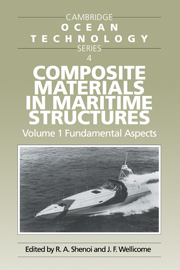Book contents
- Frontmatter
- Contents
- Preface
- List of Authors
- 1 A Strategic Overview
- 2 Background to Materials Science
- 3 Environmental Aspects
- 4 Production by Resin Transfer Moulding
- 5 An Engineering Approach to the Prediction of Elastic Properties of a Laminate
- 6 Mechanics of Orthotropic Laminae
- 7 Analysis of Laminated Composites
- 8 Theory of Sandwich Beams and Plates
- 9 Design of Anisotropic Panels
- 10 Finite Element Analysis of Composites
- 11 Theoretical Predictions of Failure Mechanisms and Strength
- 12 Considerations of Failure Theories in Design
- 13 The Procedures and Standards
- Appendix
- Index
9 - Design of Anisotropic Panels
Published online by Cambridge University Press: 04 August 2010
- Frontmatter
- Contents
- Preface
- List of Authors
- 1 A Strategic Overview
- 2 Background to Materials Science
- 3 Environmental Aspects
- 4 Production by Resin Transfer Moulding
- 5 An Engineering Approach to the Prediction of Elastic Properties of a Laminate
- 6 Mechanics of Orthotropic Laminae
- 7 Analysis of Laminated Composites
- 8 Theory of Sandwich Beams and Plates
- 9 Design of Anisotropic Panels
- 10 Finite Element Analysis of Composites
- 11 Theoretical Predictions of Failure Mechanisms and Strength
- 12 Considerations of Failure Theories in Design
- 13 The Procedures and Standards
- Appendix
- Index
Summary
INTRODUCTION
Design of any artefact is not an activity undertaken in isolation. Although the designer may start, metaphorically, with a blank sheet of paper, he will have a solution in mind based usually on historical or traditional perceptions. There will also be in mind the function or purpose of the artefact which is the reason for the design. Ideally it should be possible to start with the function and to derive the required characteristics of the artefact directly. However, this direction of attack will only be possible for the simplest of objects, and for all practical cases it will be necessary to conceive characteristics and to predict the function from them. If the function does not match that which is required then an iterative procedure is followed.
It is also necessary to be aware of the environment in which the artefact is to function. A description of the environment in terms of loads, temperature, humidity, etc. and the time variation of these will usually be part of the functional specification. If not, it must be derived by the designer before he can start on the design.
Moving on from the philosophy, what is required for the design of plate panels? In the present context a plate panel will be part of a marine structure, and will be loaded by some or all of in-plane biaxial loads, lateral loads and shear, and these loads will frequently be cyclic. The environment is likely to be wet, and in some parts of the structure may well be hot.
- Type
- Chapter
- Information
- Composite Materials in Maritime Structures , pp. 236 - 254Publisher: Cambridge University PressPrint publication year: 1993

